英语语言学导论
- 格式:doc
- 大小:354.00 KB
- 文档页数:43
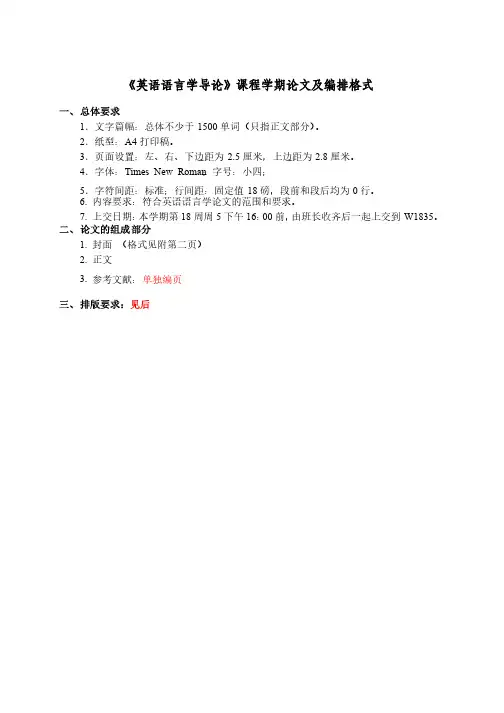
《英语语言学导论》课程学期论文及编排格式一、总体要求1.文字篇幅:总体不少于1500单词(只指正文部分)。
2.纸型:A4打印稿。
打印稿。
3.页面设置:左、右、下边距为2.5厘米,上边距为2.8厘米。
厘米。
4.字体:Times New Roman;字号:小四;;字号:小四;5.字符间距:标准;行间距:固定值18磅,段前和段后均为0行。
行。
6. 内容要求:符合英语语言学论文的范围和要求。
7. 上交日期:本学期第18周周5下午16:00前,由班长收齐后一起上交到W1835。
二、论文的组成部分1. 封面(格式见附第二页)封面 (格式见附第二页)2. 正文正文3. 参考文献:单独编页参考文献:单独编页三、排版要求:见后常州大学外国语学院英语系《英语语言学导论》课程学期论文姓名:__________________________________ 班级:__________________________________ 学号:__________________________________ 成绩:__________________________________二○一三年十二月conflict between the id and the superego. The former is characterized by her strong drive of independence independence and and and imagination, imagination, imagination, which which which explains explains explains why why why Isabel Isabel Isabel chooses chooses chooses to to to marry marry marry Osmond. Osmond. Osmond. The The latter latter is is is characterized characterized characterized by by by her her her consciousness consciousness consciousness of of of social social social requirements requirements requirements and and and ego-ideal ego-ideal ego-ideal of of of being being perfect by acquiring European civilization, which accounts for the reason why Isabel chooses to maintain her tragic marriage with Osmond. (空一行)《英语语言学导论》评分标准该课程共32学时,为考查课,成绩评定采取课程论文的形式。


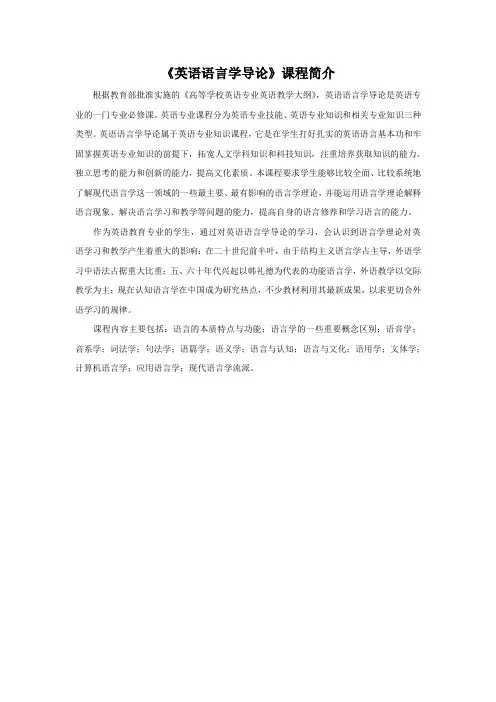
《英语语言学导论》课程简介
根据教育部批准实施的《高等学校英语专业英语教学大纲》,英语语言学导论是英语专业的一门专业必修课。
英语专业课程分为英语专业技能、英语专业知识和相关专业知识三种类型。
英语语言学导论属于英语专业知识课程,它是在学生打好扎实的英语语言基本功和牢固掌握英语专业知识的前提下,拓宽人文学科知识和科技知识,注重培养获取知识的能力、独立思考的能力和创新的能力,提高文化素质。
本课程要求学生能够比较全面、比较系统地了解现代语言学这一领域的一些最主要、最有影响的语言学理论,并能运用语言学理论解释语言现象、解决语言学习和教学等问题的能力,提高自身的语言修养和学习语言的能力。
作为英语教育专业的学生,通过对英语语言学导论的学习,会认识到语言学理论对英语学习和教学产生着重大的影响:在二十世纪前半叶,由于结构主义语言学占主导,外语学习中语法占据重大比重;五、六十年代兴起以韩礼德为代表的功能语言学,外语教学以交际教学为主;现在认知语言学在中国成为研究热点,不少教材利用其最新成果,以求更切合外语学习的规律。
课程内容主要包括:语言的本质特点与功能;语言学的一些重要概念区别;语音学;音系学;词法学;句法学;语篇学;语义学;语言与认知;语言与文化;语用学;文体学;计算机语言学;应用语言学;现代语言学流派。


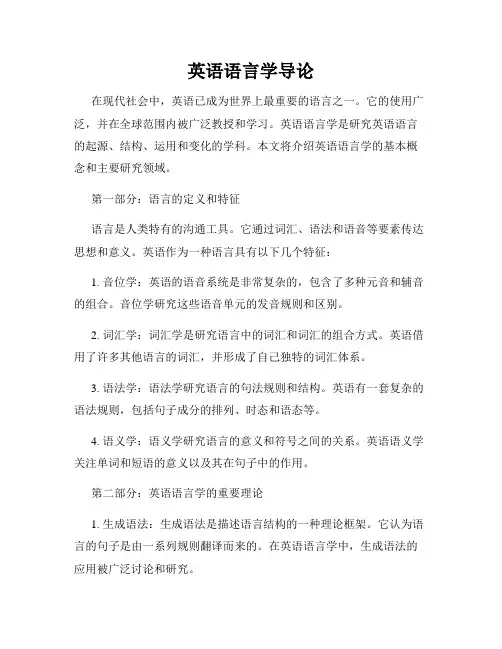
英语语言学导论在现代社会中,英语已成为世界上最重要的语言之一。
它的使用广泛,并在全球范围内被广泛教授和学习。
英语语言学是研究英语语言的起源、结构、运用和变化的学科。
本文将介绍英语语言学的基本概念和主要研究领域。
第一部分:语言的定义和特征语言是人类特有的沟通工具。
它通过词汇、语法和语音等要素传达思想和意义。
英语作为一种语言具有以下几个特征:1. 音位学:英语的语音系统是非常复杂的,包含了多种元音和辅音的组合。
音位学研究这些语音单元的发音规则和区别。
2. 词汇学:词汇学是研究语言中的词汇和词汇的组合方式。
英语借用了许多其他语言的词汇,并形成了自己独特的词汇体系。
3. 语法学:语法学研究语言的句法规则和结构。
英语有一套复杂的语法规则,包括句子成分的排列、时态和语态等。
4. 语义学:语义学研究语言的意义和符号之间的关系。
英语语义学关注单词和短语的意义以及其在句子中的作用。
第二部分:英语语言学的重要理论1. 生成语法:生成语法是描述语言结构的一种理论框架。
它认为语言的句子是由一系列规则翻译而来的。
在英语语言学中,生成语法的应用被广泛讨论和研究。
2. 语言变化:语言变化研究语言在时间和空间上的变化。
英语是一个活跃的语言,它经历了多次变化和演化。
研究英语变化可以帮助我们理解语言的发展和演变过程。
3. 语用学:语用学关注语言使用的背景和意图。
在英语语言学中,语用学研究口语交流、演讲和修辞等方面。
第三部分:英语作为国际语言的影响英语作为国际语言对全球化和文化交流产生了重要影响。
它被广泛用于商务、科技和学术交流等领域。
英语语言学的研究对英语作为国际语言的发展和应用具有重要意义。
1. 跨文化交际:英语作为国际语言使不同文化之间的交流更加方便。
研究跨文化交际可以帮助人们更好地理解和应对跨文化交流中的障碍和挑战。
2. 语言教育:英语作为国际语言受到广泛学习者的关注和学习。
英语语言学的研究对英语教育的改进和发展具有重要作用。
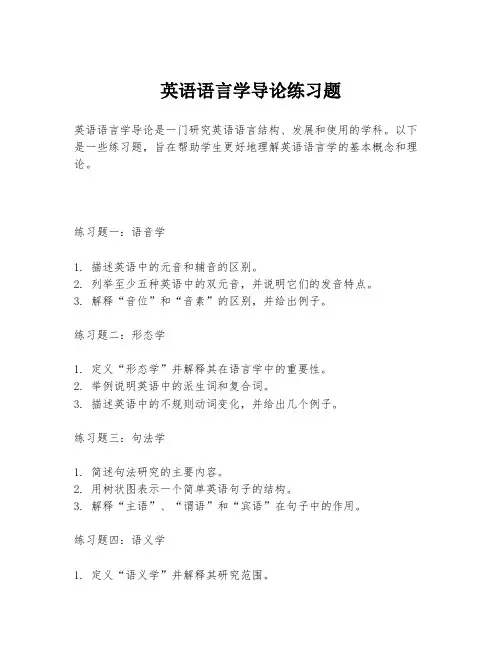
英语语言学导论练习题英语语言学导论是一门研究英语语言结构、发展和使用的学科。
以下是一些练习题,旨在帮助学生更好地理解英语语言学的基本概念和理论。
练习题一:语音学1. 描述英语中的元音和辅音的区别。
2. 列举至少五种英语中的双元音,并说明它们的发音特点。
3. 解释“音位”和“音素”的区别,并给出例子。
练习题二:形态学1. 定义“形态学”并解释其在语言学中的重要性。
2. 举例说明英语中的派生词和复合词。
3. 描述英语中的不规则动词变化,并给出几个例子。
练习题三:句法学1. 简述句法研究的主要内容。
2. 用树状图表示一个简单英语句子的结构。
3. 解释“主语”、“谓语”和“宾语”在句子中的作用。
练习题四:语义学1. 定义“语义学”并解释其研究范围。
2. 描述“同义”和“反义”的概念,并给出英语例子。
3. 解释“语境”如何影响语言的意义。
练习题五:语用学1. 什么是语用学?它与语义学有何不同?2. 描述“指示语”、“礼貌原则”和“合作原则”在交际中的作用。
3. 举例说明如何在不同的社交场合中使用不同的语言风格。
练习题六:社会语言学1. 解释社会语言学研究的主要内容。
2. 讨论语言变异与社会身份之间的关系。
3. 描述双语现象及其对语言使用者的影响。
练习题七:心理语言学1. 心理语言学是如何研究语言的?2. 描述“语言习得”的过程及其理论。
3. 讨论“母语”和“第二语言”学习之间的差异。
练习题八:历史语言学1. 定义“历史语言学”并解释其研究目的。
2. 描述英语的发展历史和主要变化。
3. 讨论语言接触和借用对语言发展的影响。
完成这些练习题将有助于加深对英语语言学各个方面的理解,并提高分析和应用语言学理论的能力。
希望这些练习题能对你的学习有所帮助。

英语语言学导论第二版课后题答案这篇课件介绍的是英语语言学导论第二版的课后题,也就是 predictional node,可以说是很多英语学习者学英语的入门。
这本课教程主要包括四个部分,第一是基础知识:英语语言学导论第二版的学习指南;第二是词汇、语法等部分内容;第三句话;第四个单元:基本语法和常识性语法。
由于这些部分主要针对英语学习者的,所以大部分人都不会太过深入。
第一部分主要介绍基本语法和常识性语法。
第二段从词汇开始教起,介绍常见单词表方法和有关单词表规则。
第三部分就是理论部分,主要对相关理论进行介绍和讲解。
第四部分则是一些语法结构、语法知识方面的练习和讲解,包括长难句设计和语义分析法等方面内容。
一、基本语法基本语法主要是指由名词、动词、形容词、谓词和定冠词等组成的句式结构。
语法有两个重要的特点,一是强调在逻辑上主谓一致和主谓宾一致;二是强调在形式上主谓一致和主宾一致。
在英文里,句式的基本形式是名词或形容词+名词修饰短语,这就决定了句子的结构是主宾并列式组合而非主谓宾非主有定冠词修饰短句。
这种结构以主从为主,主从搭配为辅,辅音连用为主就成了这种结构典型例句。
如: go up with not a london’s a doing; to was in the way for the doing; was the doing of this will with london; but as that way so that in the denim; proposition of that to that dots等。
这种结构式语法类型。
还有一些例子表明主谓一致或主次有序在形式上没有明显区别。
这种结构式还可以用不同形式表示宾语、代词和不定冠词等等;也有一些句子仅在主句之间使用谓词介辞方式而不运用动词主句的时候会用谓语短词组替代原句主句中未出现过的或不需要过多动词介辞元素(如 frontiers、 state等)而不用宾语或非宾语修饰动词和介词短语等。
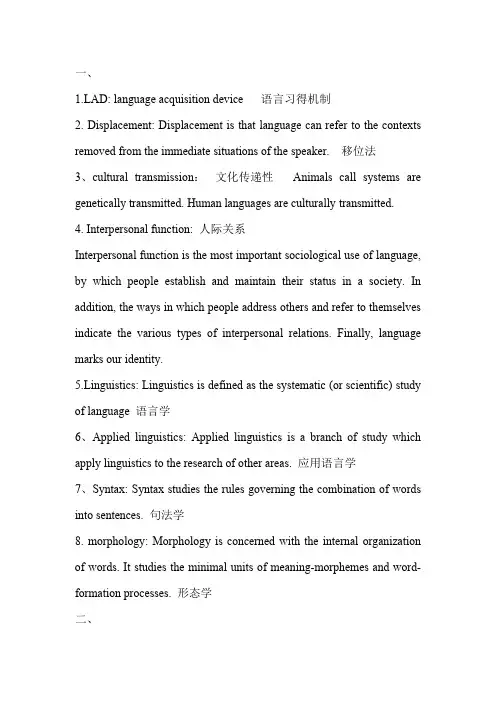
一、D: language acquisition device 语言习得机制2. Displacement: Displacement is that language can refer to the contexts removed from the immediate situations of the speaker. 移位法3、cultural transmission:文化传递性Animals call systems are genetically transmitted. Human languages are culturally transmitted.4. Interpersonal function: 人际关系Interpersonal function is the most important sociological use of language, by which people establish and maintain their status in a society. In addition, the ways in which people address others and refer to themselves indicate the various types of interpersonal relations. Finally, language marks our identity.5.Linguistics: Linguistics is defined as the systematic (or scientific) study of language 语言学6、Applied linguistics: Applied linguistics is a branch of study which apply linguistics to the research of other areas. 应用语言学7、Syntax: Syntax studies the rules governing the combination of words into sentences. 句法学8. morphology: Morphology is concerned with the internal organization of words. It studies the minimal units of meaning-morphemes and word-formation processes. 形态学二、1. Language acquisition and language learningLanguage acquisition is to get a language subconsciously and naturally with no great effort. Language learning is to get a language consciously with great efforts and usually under the teachers’ instruction.For instance, for most Chinese, their knowledge about their mother tongue-Chinese, is language acquisition, while their knowledge about English is language learning.2. Foreign language and second languageA language has gained official status in certain region or country is called second language, while foreign language has not.For example, for most Indians, English is their second language since English has gained official status in their country while English is regarded as foreign language in China.3. Expressive function and Evocative functionExpressive function is the use of language to reveal something about the feelings and attitudes of the speaker. In this function, language is used to evaluate, appraise and assert the speaker’s attitudes, etc.Evocative function is the use of language to create certain feelings in the hearer. It aims to amuse, startle, anger, soothe, worry or please.4. Phonetics and Phonology.Phonetics studies speech sounds, including the production of speech, that is, how speech sounds are actually made, transmitted and received, thedescription and classification of speech sounds, words and connected speech.Phonology is the branch of linguistics which studies the sound patterns of languages.5. Semantics and PragmaticsSemantics studies the meaning of languagePragmatics is the study of meaning in context.6. Synchronic and DiachronicSynchronic description takes a fixed instant as its point of observation. Diachronic linguistics is the study of a language through the course of its history.7. Langue and paroleLangue is the linguistic competence of the speaker. It refers to the abstract linguistic system shared by all the members of a speech community.Parole is the actual phenomena or data of linguistics. It refers to the actualized language.Langue is abstract, stable, systematic and not actually spoken by anyone. Parole is specific, personal, subject to personal and situational constraints and always a naturally occurring event.petence and performance(语言能力和语言运用)A language user’s underlying knowledge about the system of rules iscalled his linguistic competence.Performance refers to the actual use of language in concrete situations.简答题:1. What are the design features of language?Arbitrariness任意性Duality二元性Creativity创造性Displacement移位性Culture transmission文化传递性Interchangeability互换性2. What is morpheme? Morpheme is the minimal unit of meaning. For example,“purify”consist of “pur” and“ify”,and the noun“disappearance” consist of three morphemes: appear, dis and ance. They all have meanings, and cannot be divided any more.3. What is phoneme? Example. Phoneme is the smallest linguistic unit of sound that can signal a difference in meaning. E.g.:/b/ /p/ /k/ /g/.4. What is the performative function of human language? Supply example s to illustrate.The performative function of language is primarily to change the social status of persons .It can also extend to the control of reality as on some magical or religions occasion .For example ,language is always used in the sentencing of criminals, the blessing of children and the naming of a ship at a launching ceremony.5. What are the basic three branches of phonetics?Articulatory phonetics, Acoustic phonetics, Auditory phonetics.6. Giving four branches of macrolinguistics.Psycholinguistics心理语言学sociolinguistics社会语言学Anthropological linguistics人类语言学Computational linguistics 计算语言学.7. What are the seven function of language.Informative信息功能interpersonal function人际功能performative 施为功能Emotive function感情功能phatic communion寒暄功能recreational function娱乐功能metalingual function元语言功能。
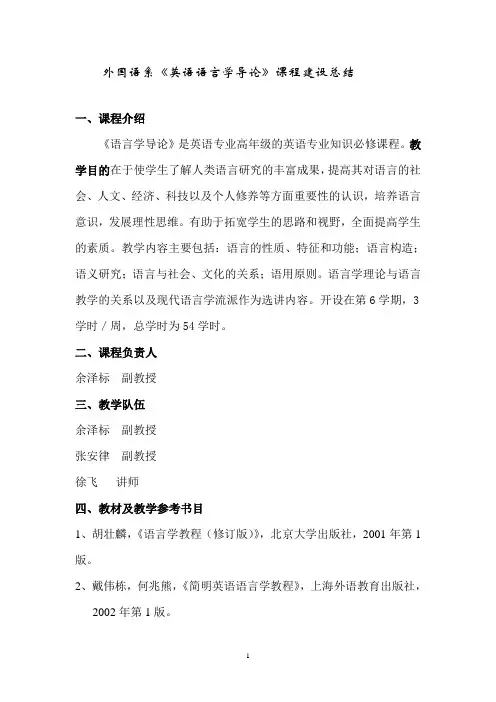
外国语系《英语语言学导论》课程建设总结一、课程介绍《语言学导论》是英语专业高年级的英语专业知识必修课程。
教学目的在于使学生了解人类语言研究的丰富成果,提高其对语言的社会、人文、经济、科技以及个人修养等方面重要性的认识,培养语言意识,发展理性思维。
有助于拓宽学生的思路和视野,全面提高学生的素质。
教学内容主要包括:语言的性质、特征和功能;语言构造;语义研究;语言与社会、文化的关系;语用原则。
语言学理论与语言教学的关系以及现代语言学流派作为选讲内容。
开设在第6学期,3学时/周,总学时为54学时。
二、课程负责人余泽标副教授三、教学队伍余泽标副教授张安律副教授徐飞讲师四、教材及教学参考书目1、胡壮麟,《语言学教程(修订版)》,北京大学出版社,2001年第1版。
2、戴伟栋,何兆熊,《简明英语语言学教程》,上海外语教育出版社,2002年第1版。
3、王德春,《语言学概论》,上海外语教育出版社,2000年第1版。
4、胡壮麟,《语言学教程(修订版中译本)》,北京大学出版社,2002年第1版。
5、杨信彰,《语言学概论》,高等教育出版社,2005年第1版。
五、教学大纲已制订有《语言学导论》课程教学大纲六、教案(附后)七、教学改革及效果1、改革教学内容和手段,采用自制多媒体课件教学,重点突出与实际语言运用相关的内容,以利于学生接受和理解。
2、突破传统教学模式,把系统的语言理论与语言分析相结合,从根本上改变语言学教学枯燥无味的教学模式,有利地促使学生认识到了对语言学理论学习的必要性和重要性。
3、学习形式多样化,重在激发学生兴趣、扩展学生积极投入学习的空间、培养有效语言思维习惯。
课堂学习既有准备充分的讲解又有启发思维的讨论,使学生既受到系统的专业训练又获得实际操作的技能。
八、建设规划规划在2008年将该课程建设成为校级重点课程,同时加强教学内容和手段的改革,制作更完善的多媒体教学课件,提高教学效果。
英语语言学导论第三版课后答案第一单元1、P______ is defined as the study of the phonic medium of language. [填空题] *空1答案:honetics答案解析:语音学被定义为对语言的语音媒介的研究;它涉及所有出现在世界语言中的声音。
2、A______ phonetics, auditory phonetics, and acoustic phonetics respectively are three branches of phonetics. [填空题] *空1答案:rticulatory答案解析:发音语言学、声学语音学、感知语音学是语音学的三大研究领域。
3、Of all the speech organs, the t______ is the most flexible, and is responsible for varieties of articulation than any other. [填空题] *空1答案:ongue答案解析:舌头是最灵活的4、English consonants can be classified in terms of manner of articulation or in terms of p______ of articulation. [填空题] *空1答案:lace答案解析:英语辅音可以根据发音方式或者发音部位来分。
5、Phonology and phonetics both are studies of s______ sounds. [填空题] *空1答案:peech答案解析:音位学与语音学都涉及到语言的同一个方面——语音。
6、The rules that govern the combination of sounds in a particular language are calleds______ rules. [填空题] *空1答案:equential答案解析:某一特定语言的语言模式是受规则支配的。
一、语言学总论1. design feature of language(语言的定义特征)defining properties of human language that distinguish it from any animal system of communication1)Arbitrariness(任意性): 象似性iconicity定义:the forms of linguistic signs bear no natural relationship to their meaning.举例:书, book, livre喜欢,like,aimer2)Duality(二层性):定义:the property of having two levels of structures, such that units of the primary level are composed of elements of the secondary level.举例:Sounds > syllables > words > phrases > clauses > sentences> texts/discourses3)Creativity/Productivity(创造性):定义:Language can be used to create new meanings because of its duality.举例1:/k/ ,/a:/, /p/---- carp or park举例2:England, defeated, FranceEngland defeated France.France defeated England.4)Displacement(替代性、移位性):定义:Human languages enable their users to symbolize something which are not present at the moment of communication.5)Cultural Transmission(文化传递性):定义:language is passed on from generation to generation through teaching and learning rather than instinct.反例:印度狼孩2. Important Distinctions in Linguistics(语言学研究中几对重要的概念)1) Descriptive (描述性)vs. Prescriptive (规定性)Descriptive: describing how things are.prescriptive: prescribing how things ought to beImportant Distinctions in Linguistics举例:Don't say X.People don't say X.The first is a prescriptive command, while the second is a descriptive statement.2). Synchronic(共时性)vs. Diachronic (历时性)synchronic: takes a fixed instant as its point of observation.diachronic: the study of a language through the course of its history.举例:研究1800年的英语发音Synchronic studies (共时性研究)研究1800-1900的法语语法变化Diachronic studies (历时研究)3). langue(语言)& parole (言语)Theorist:Saussure(索绪尔), father of modern linguisticslangue: abstract linguistic systemparole: actual realization of langueImportant Distinctions in Linguistics4) Competence(语言能力)and performance (语言运用)theorist: Chomsky(乔姆斯基)competence: user's knowledge of rules about the linguistic system.performance: the actual realization of this knowledge in concrete situations.二、语音学和音系学1.语音学(phonetics)和音系学(phonology)的定义和区别2.语音学重要概念: 清音和浊音3.音系学重要概念: 音子,音位, 超音段特征Phonetics studies all speech sounds in human languages: how they are produced, transmitted and how they are received.Phonology: aims to discover how speech sounds in a language form patternsand how these sounds are used to convey meaning in linguistic communication.区别: meaning(是否研究和表达意义有关的语音)举例:too 和tea 中的/t/发too中的/t/时, 舌位更靠近口腔前部发tea中的/t/时,舌位更靠近口腔后部语音学要研究这种/t/发音的不同之处, 音系学不研究语音学分类articulatory phonetics(发音语音学): speakers productionacoustic phonetics(声学语音学): transmission’s mediumauditory phonetics(听觉语音学): receiver’s receptionHow speech sounds are madeSpeech organsPosition of the vocal folds(声带): voicing(浊音) and voiceless (清音)Voiceless(清音):vocal cords are drawn wide apart, letting the air stream go through without causing obstruction清音举例:[p,s,t]Voicing/Voiced(浊音):vocal cords held together, letting the air stream vibrates浊音: [b,z,d]The distinction between vowels and consonants lies in the obstruction of air stream.As there is no obstruction of air in the production of vowels, the description of the consonants and vowels cannot be done along the same lines.音系学重要概念:Phone(音子):a phonetic unit; the speech sounds we hear and produce during communication are all phones举例:too 和tea 中的/t/发too中的/t/时, 舌位更靠近口腔前部发tea中的/t/时,舌位更靠近口腔后部所以too 和tea 中的/t/两个不同的音子Phoneme(音位): phonological and abstract unit, a unit of distinctive value;the smallest unit of sound in a language which can distinguish two words.举例:tea 和sea, /t/和/s/是两个不同的音位morphemeSuprasegmental features (超音段特征)Suprasegmental features: phonemic features that occur above the level of the segments .The principal suprasegmentals are:stress (重音)举例: perfect (adj) 和perfect (v)tone (声调)/pitch (音高):定义: sound feature which are caused by the differing rate of vibration of the vocal folds.举例: mā妈, má麻, mă马,mà骂比较:英语单词,如meintonation (语调):pitch, stress, and sound length are tied to the sentence rather than the word in isolation.三、Morphology 形态学1. 学科定义2. 语素的定义和分类3. 词的分类(classification of words)形态学研究的基本单位1. morpheme(语素). The most basic element of meaning in language,an element that cannot be further divided into smaller units without altering its meaning.举例:ballfootballballsTypes of MorphemesFree morphemes vs. Bound morphemes(自由语素和黏着语素):Free morphemes: those that may constitute words by themselves, eg boy, girl, table, nation. Bound morphemes: those that cannot occur alone, eg -s, -ed, dis-, un-.Types of Bound MorphemeInflectional morpheme (屈折语素)=inflectional affix(屈折词缀):change the grammatical meaning (number, aspect, case, tense)Derivational morpheme(派生语素)=derivational affix (派生词缀): change the lexical meaningDerivational morpheme(改变词义):改变词义:dis-, un-, multi-, micro-改变词性:en-, -full, -mentInflectional morpheme(改变语法含义):改变名称的性,数,格:-ess, -s,改变动词的时, 态,体: -ing, -ed,改变形容词的级:-er, -est如何区分派生词(derivational word)和合成词(compound word) : 拆开后看各个组成的语素能否都单独成词,如果可以,就是合成词,如果不能就是派生词。
英语专业语言学导论考试试题一、选择题1、以下哪个选项不属于语言学的范畴?A.语音学B.句法学C.语义学D.政治学2、下列哪一项不是语言学的研究对象?A.语言的发音机制B.语言的语法结构C.语言的社交功能D.语言的生物属性3、哪种语言学理论认为语言是自然现象?A.行为主义理论B.先天语言能力理论C.进化语言学理论D.交际语言学理论二、简答题1、请简述语言学中的索绪尔假设是什么?并解释其对语言学研究的影响。
2、请阐述结构主义语言学的基本观点及其主要贡献。
3、请说明语言学中的“能指”和“所指”概念,并举例说明。
三、论述题1、请结合实例论述语言学中的“语境”概念,以及它在语言使用中的作用。
2、请阐述语言学中的“言语行为理论”,并说明其对语言习得和语言交际的指导意义。
四、分析题请分析以下这段话,并说明其中涉及了哪些语言学概念?“在这个句子中,主语是‘我’,谓语是‘喜欢’,宾语是‘巧克力’,这是一个简单的陈述句。
”(提示:句子结构、主谓宾、句法等)以下哪个不是教育技术学的主要研究对象?()教育技术学中的“技术”一词通常指的是()。
以下哪一项不是教育技术学的发展历程?()以下哪个理论是教育技术学中的基础理论?()请从技术角度说明教育技术学对教育的推动作用。
请论述教育技术学对教育改革的影响。
专业英语八级考试是针对英语专业学生的高难度语言考试,旨在测试学生的英语综合能力,包括听力、阅读、写作和翻译等方面的技能。
以下是一份专业英语八级考试试题的样例,供大家参考。
听一段录音材料,根据问题选择答案。
录音材料涉及一些学术领域的讨论,包括社会科学、自然科学等。
问题类型包括选择题和填空题。
阅读一篇文章,回答问题。
文章可能涉及一些学术领域的内容,包括社会科学、自然科学等。
问题类型包括选择题和问答题。
根据给定的主题写一篇文章,字数要求在500字左右。
文章主题可能涉及一些学术领域的内容,例如文化、历史、经济等。
文章需要结构清晰,语法正确,表达准确。
语言学导论复习一.名词解释1.Broad transcription(宽式音标):Broad transcription is the transcription with letter-symbols only. This is the transcription normally used in dictionaries and teaching textbooks for general purposes.ponential[.k?mp?'nen??l]analysis(成分分析): Componential analysis is a way proposed by the structural semanticists[s?'m?nt?sist]to analyze word meaning. The approach is based on the belief that the meaning of a word can be dissected into meaning components, called semantic features.3.Interlanguage(中介语;过渡语):Proposed by S. Pit Corder and Larry Selinker, the concept of interlanguage was established as learners’ independent system of the second language which is of neither the native language nor the second language, but a continuum [k?n'tinju?m]or approximation [?.pr?ksi'mei??n] n. 接近,近似from his native language to the target language.petence & performance(语言能力和语言行为):Chomsky defines competence as the ideal user’s knowledge of the rules of his language, and performance the actual realization of this knowledge in linguistic communication.5. Context(语境): The notion of context is essential to the pragmatic study of language. It is generally considered as constituted by the knowledge shared by the speaker and the hearer, such as cultural background, situation, the relationship between the speaker and the hearer, etc.nguage Acquisition(语言习得):Language acquisition refers to the child’s acquisition of his mother tongue, i.e. how the child comes to understand and speak the language of his community.7.Sapir-Whorf Hypothesis [hai'p?θisis](萨丕尔-沃尔夫假说):Sapir and Whorf, proclaimed that the structure of the language people habitually use influences the ways they think and behave. Sapir and Whorf believe that language filters过滤people’s p erception感官,观念and the way they categorize分类experiences. This interdependence互相依赖of language and thought is now known as Sapir-Whorf Hypothesis.nguage Acquisition Device(语言习得机制):The linguist Noam Chomsky claims that human beings are biologically [bai?'l?d?ikli] 生物学地programmed for language and that the language develops in the child just as other biological functions such as walking. Originally Chomsky referred to this innate天生的ability as Language Acquisition Device, (also known as LAD).二.论述题1. What are the major views concerning the study of meaning?(1) The naming theory命名论One of the oldest notions concerning meaning, and also the most primitive one, was the naming theory proposed by the ancient Greek scholar Plato.The view holds that words are just names or labels称谓for things.(2) The conceptualist view 概念论This viewholds that there is no direct link between a linguistic form and what it refers to (i.e. between language and the real world); rather, in theinterpretation解释of meaning they are linked through the mediation of concepts in the mind.(3)Contextualism语境论The view holds that meaning should be studied in terms of situation, use, context —elements closely linked with language behaviour.(4)Behaviorism行为主义论Behaviorists attempted to define the meaning of a language form as the “situation in which the speaker utters it and the response it calls forth 唤起,引起in the hearer”.(Bloomfield)2. According to Austin, what are the three acts a person is possibly performing while making an utterance. Give an example.According to Austin, a speaker might be performing three acts when speaking: locutionary [l?u'kju:??n?ri]act(言内行为), illocutionary act(言外行为) , and perlocutionary act. (言后行为)A locutionary act is the act of uttering words, phrases and clauses. It is the act of conveying literal meaning by means of syntax, lexicon and phonology.An illocutionary act is the act of expressing the speaker’s intention; it is the act performed in saying something. A perlocutionary act is the act performed by or resulting from saying something; it is the consequence of, or the change brought about by the utterance; it is the act performed by saying something.For example:“You have left the door wide open.” The locutionary act is the saying of it with its literal meaning: you have left the door open. The illocutionary act can be a request of the hearer to close the door, or making a complaint, depending on the context. The perlocutionary act refers to the effect of the utterance. It can be the hearer’s closing the door or his refusal to comply with the request.3. What are the main features of human language that have been specified by C. Hockett to show that it is essentially different from animal communication system?Design features refer to the defining properties of human language thatdistinguish it from any animal system of communication.(1)Arbitrariness(任意性)This means that there is no logical connection between meanings and sounds. However, language is not entire arbitrary; certain words are motivated. Some compound words are also not entirely arbitrary. But non-arbitrary words make up only a small percentage of the vocabulary of a language.(2)Productivity (能产性)Language is productive or creative in that it makes possible the construction and interpretation of new signals by its users. Productivity is unique to human language.(3)Duality(二层性)Language is a system, which consists of two sets of structures, or two levels. At the lower or the basic level there is a structure of sounds, which are meaningless by themselves. But the sounds of language can be grouped and regrouped into a large number of units of meaning, which are found at the higher level of the system. This duality of structure of language enables its users to talk about anything within their knowledge.(4) Displacement(移位性)Language can be used to refer to contexts removed from the immediate situations of the speaker.(5) Cultural transmission(文化传承性)We were all born with the ability to acquire language, the details of any language system are not genetically transmitted, but instead have to be taught and learned. The process whereby凭借conj. language is passed on from one generation to the next is described as cultural transmission. Language is culturally transmitted. In contrast, animal call systems are genetically transmitted基因遗传.。
英语语言学导论知到章节测试答案智慧树2023年最新西安外国语大学第一章测试1.Which feature incorporates the capacity to talk messages that are unrelatedto here and now. ()参考答案:Displacement;ually grammar is divided into the components of().参考答案:phonetics and phonology;;morphology and syntax;;semantics.3.Although languages are different in many respects, such as sound patterns,vocabulary, word order, there are important grammatical principles andfeatures that hold commonly in all human languages. ( )参考答案:对4.What enables us to identify well-formed sentences from non-sentences is ourgood linguistic performance in that language other than linguisticcompetence. ( )参考答案:错5.The fact that a parrot can be taught to reproduce some human speech soundsproves that human language is not unique to us. ( )参考答案:错第二章测试1.How many morphemes are there in the word “frightening”? ( )参考答案:three2.Which of the following two-term sets shows the feature of complementarity?( )参考答案:single/married3.The word “man” is an alyzed as comprising the semantic features of[+human,+adult,+male]. ( )参考答案:对4.“-tain” in words like “maintain”, “sustain”, “retain” is a ( ).参考答案:bound root5.Tree diagrams are used to represent the linear structure of words. ( )参考答案:错第三章测试1.Phrase structure rules allow us to better understand _____________. ( )参考答案:All of the above.2.The sentence structure is ________. ( )参考答案:both linear and hierarchical3.The syntactic rules of any language are ____ in number. ( )参考答案:finite4.In English syntactic analysis, four phrasal categories are commonlyrecognized and discussed, namely, noun phrase, verb phrase, infinitivephrase, and auxiliary phrase. ( )参考答案:错5.What is actually internalized in the mind of a native speaker is a complete listof words and phrases rather than grammatical knowledge. ( )参考答案:错第四章测试1.Reflected meaning arises in cases of multiple conceptual meanings, when onesense is associated with another sense. ( )参考答案:对2.The lexical relationship between “bear” and “bare” is hyponymy. ( )参考答案:错3.The sentence It is hot is a one-place predication. ( )参考答案:错4.Pragmatics is the study of language meaning. ( )参考答案:错5.According to John Searle’s classification of speech acts, “he promises to cometomorrow” is ( ).参考答案:representative第五章测试1.Which one is different from the others according to place of articulation? ( )参考答案:[n]2.Which of the following is NOT a front vowel? ( )参考答案:[u:]3.[z] is a voiceless, alveolar fricative consonant while [j] is a palatalapproximant. ( )参考答案:错4.[p] is a voiced bilabial stop. ( )参考答案:错5.Perceptual phonetics is concerned with the perception of speech sounds. ( )参考答案:对第六章测试1.Distinctive features can be found running over a sequence of two or morephonemic segments. The phonemic features that occur above the level of the segments are called ( ).参考答案:suprasegmental features2.How many morphemes are there in the word “discharged”? ( )参考答案:33.Which of the following statements about allophone is NOT correct? ( )参考答案:Allophones distinguish meaning.4. A phoneme in a language is a distinctive sound which is capable ofdistinguishing one word or one shape of a word from another. ( )参考答案:对5.Phonology is concerned with how the sounds can be classified into differentcategories. ( )参考答案:错第七章测试pared with langue, parole is chaotic and therefore impossible to study. ( )参考答案:错2.The common types of language variation are variation. ( )参考答案:all of above3.William Labov’s New York Department Store study is basically about regionalvariation of language. ( )参考答案:错nguage contact could lead to the death of a language. ( )参考答案:对5.When speakers from different languages interact with each other, one of thenative languages of the speakers could be used as a lingua franca. ()参考答案:错第八章测试1.There are five major stages in the history of English language change. ( )参考答案:对2.Who is the editor of Dictionary of the English language? ( )参考答案:Samuel Johnson3.The lexical change includes: ( )参考答案:borrowing or Loan Words;the addition of new words;change in lexical category;loss of words4.The word change from “bathe” to “bath” is syntactic change ( )参考答案:错5.Changes in a language are changes in the grammars. ()参考答案:错第九章测试1.Traditional behaviourists view language as a kind of behaviour and believethat language learning is simply a matter of imitation and habit formation. ( ) 参考答案:对2.Chomsky proposed that human beings are born with an innate ability knownas _______. ( )参考答案:Language Acquisition Device, or LAD3.Unlike L1 acquisition, which is uniformly successful across children andlanguages, adults vary considerably in their ability to acquire an L2completely. ( )参考答案:对4.What are the three interacting factors in determining language transfer insecond language learning? ( )参考答案:A learner’s perception of native-target language distance.;A learner’s actual knowledge of the target language.;A learner’s psychology, how a learner organizes his or her nativelanguage.5.The native language influences not only occur as direct linguistic reflexes atphonological, lexical, semantic, syntactical or discoursal levels but alsodirectly reflect underlying organizational principles of languages at thecognitive level. ( )参考答案:对第十章测试1.Which area of linguistics studies the cognitive processes of how we use ourlinguistic competence in speech production and comprehension? ( )参考答案:Psycholinguistics2.In psycholinguistic experiments which of the following is frequently used asan important measurement of how quick a person responds to linguisticsignals. ( )参考答案:Response time (RT)3. A central problem of speech perception is to explain how listeners carve upthe continuous speech signal into meaningful unit. This is referred to as the segmentation problem. ( )参考答案:对4.In Top-down processing listeners move step-by-step from the incomingsignal, to phonemes, morphemes, words and phrases and ultimately tosemantic interpretation. ( )参考答案:错5. A listener will respond faster at making lexical decision on related wordssuch as doctor and nurse than if he just heard unrelated word such as doctor and flower. This is possibly because words in the first pair are semantically related. ( )参考答案:对第十一章测试1.Many people use the search features of the Internet to find information.Typically, one enters a keyword, or perhaps several, and magically thecomputer returns the location of Web sites that contain information relatingto that key-word. This process is an example of ( ).参考答案:information retrieval2.Many crimes involve anonymous recorded messages in which it is importantto identify the speaker. ______ is the use of computers to assist in such a task,as opposed to ear witnessing, which relies on the judgment of humanlisteners. ( ).参考答案:Speaker identification3.The field of computational lexicography is concerned not only with themaking of standard dictionaries but also with the building of electronicdictionaries specifically designed for computational linguists. ( )参考答案:对4.Speech synthesis is a two-step process in which a text-to-speech programfirst converts text to phones or other basic units such as words or syllables. ( ) 参考答案:对5.The computational linguistics of speech understanding and speechgeneration has the subfields of computational phonetics and phonology,computational morphology, computational syntax, computational semantics, and computational pragmatics. ( )参考答案:对第十二章测试1.The history of writing includes____. ( )参考答案:Cuneiform Writing;pictograms and ideograms;from hieroglyphics to the Alphabet writing;the Rebus principle2.ʘrepresents the sound “___” ( )参考答案:sun3.The current English is a kind of picture system. ( )参考答案:错4.The Phoenician living in the area from hieroglyphics to the Alphabet writing.( )参考答案:对5.“cat cats cat’s cats’”have four morphemes. ( )参考答案:错第十三章测试1.The Prague School is a school of linguistic thought and analysis established inPrague in the 1920s by Mathesius. ()参考答案:对2.The major linguistic schools include ( )参考答案:The Formalism;The Functionalism;The Structuralism;The cognitivism3.The major scholars mentioned in American Structuralism are ( )参考答案:Franz Boas;Leonard Bloomfield;Edward Sapir4.The famous linguistic work Metaphors We live By is composed by RonaldLangacker。
Chapter 1 Introduction介绍1.语言定义What is languageLanguage is a system of arbitrary vocal symbols used for human communication.First, language is a system, i.e. elements of language are combined according to rules. This explains why “iblk” is not a possible sound combination in English, and also why “Been he wounded has” is not a grammatically acceptable sentence in English.Second, language is arbitrary in the sense that there is no intrinsic connection between a linguistic symbol and what the symbol stands for, for instance, between the word “pen” and the thing we write with. Different languages have different words for the same object. Words are just symbols. “A rose by any other name would smell as sweet.” Shakespeare’s play “Romeo and Juliet”.Third, language is vocal because the primary medium for all languages is sound. All evidence points to the fact that writing systems came into being much later than the spoken forms and that they are only attempts to capture sounds and meaning on paper. The fact that children acquire spoken language before they can read or write also indicates that language is primarily vocal.2. 语言特征Design Features of LanguageDesign features refer to the defining properties of human language that distinguish it from any animal system of communication.Charles Hockett (American) in 1960 : (5 of 13)①Arbitrariness 任意性: There is no logical connection between meanings and sounds.(A good example is the fact that different sounds are used to refer to the same object in different languages.) On the other hand, language is not entirely arbitrary, such like onomatopoeic words and some compound words.②Productivity 多产性: Language is productive or creative in that it makes possible the construction and interpretation of new signals by its users.③Duality 双重性: Language is a system, which consists of two levels. The basic level is a structure of sounds, and the higher level is the units of meaning.④Displacement 移位性: Language can be used to refer to contexts removed from the immediate situations of the speaker.⑤Cultural transmission 文化传承性: Language is passed on from one generation to the next through teaching and learning, rather than by instinct.3.语言功能Function of LanguageThree main functions : the descriptive function, the expressive function and the social function.①The descriptive function: also referred to differently as the cognitive, or referential, or propositional function, is assumed to be the primary function of language.It is the function to convey factual information, which can be asserted or denied, and in some cases even verified.②The expressive function: also called the emotive or attitudinal function, supplies information about the user’s feelings, preferences, prejudices, and values.③The social function: also referred to as the interpersonal function, serves to establish and maintain social relations between people.Roman Jakobson (Russian-born) :He identifies six elements of a speech event and relates each one of them to one specific language function.①Addresser, Emotive 情感功能The addresser expresses his attitude to the topic or situation of communication.②Addressee, Conative 意动功能The addresser aims to influence the addressee’s course of action or ways of thinking.③Context, Referential 信息功能The addresser conveys a message of information.④Message, Poetic 诗性功能The addresser uses language for the sole purpose of displaying the beauty of language itself.⑤Contact, Phatic communication 寒暄功能The addresser tries to establish or maintain good interpersonal relationship with the addressee.⑥Code.Metalinguistic 元语言,纯理功能The addresser uses language to make clear the meaning of language itself, e.g. “Let me tell you what the word ‘linguist’ means.”M.A.K. Halliday (British) in the early 1970s :He explored the functions of child language, and found that as a child grew into an adult the7 functions are gradually replaced by a more abstract system of functions.①Ideational 经验功能: The ideational function is to organize the speaker or writer’sexperience of the real or imaginary world. It corresponds closely to the descriptive function, but it is broader because it also includes the expression of the speaker’s attitude, evaluation, his feelings and emotions.②Interpersonal 人际功能: The interpersonal function is to establish or maintain socialrelationships between people.③Textual 语篇功能: The textual function is to organize written or spoken texts in such amanner that they are coherent within themselves and fit the particular situation in which they are used.4.语言学定义What is LinguisticsLinguistics is generally defined as the scientific study of language.(Linguistics studies not any particular language, but it studies languages in general.)(It is a scientific study because it is based on the systematic investigation of linguistic data, conducted with reference to some general theory of language structure.)5.语言学范围the scope of linguisticsRelatively independent branches within the area of linguistics, and also the core of linguistics:①Phonetics语音学: The study of sounds used in linguistic communication.②Phonology音位学: how sounds are put together and used to convey meaning in communication.③Morphology形态学: The study of the way in which symbols are arranged and combined to form words.④Syntax 句法学: the study of rules that govern the combination of words to form grammatically permissible sentences in languages.⑤Semantics语义学: In most general terms language is used to convey meaning. The study of meaning is known as semantics.⑥Pragmatics语用学: Language communication does not occur in a vacuum, it always occurs in a context. The study of meaning in the context of language use is called pragmatics. Interdisciplinary branches of linguistic study: sociolinguistics社会语言学psycholinguistics 语言心理学applied linguistics 应用语言学。
Course Name:
Introduction to Linguistics
Sept. 2012, for Grade 2010 Classes 1-6
English Undergraduate Program
Department of English
School of Foreign Language Studies
Nanchang University (NCU)
Course Instructor: Prof./Dr. JIANG
Syllabus
Course Description:
This course aims at providing undergraduate juniors of English major with a fundamental and systematic account of the basic knowledge of the studies of linguistics at the modern time with explanations, illustrations, and necessary examples from the course book and also from present English and Chinese language uses, to help develop the students’ interest in this study, to facilitate their understanding of the linguistic terms and theories, and to build a systematic knowledge of the said study.
Major Books Used for this Course:
1)Hu, Zhuanglin 2006.Linguistics. A Course Book (Third Edition). Beijing
University Press, used as students’ course book.
2) Robins, R. H. 1967/1997. A Short History of Linguistics (4th edn). London, New
York: Longman.
4) Yule, George. 2000. The Study of Language. Beijing: Foreign Language Teaching
and Research Press.
5) Keith Brown et al. (eds.) 2006. Encyclopedia of Language and Linguistics (2nd edn),
Oxford: Elsevier.
6) Collinge, N. E. (ed.) 2005. An Encyclopaedia of Language. London, New York:
Routledge.
7) Strazny, Philipp (ed.) 2005. An Encyclopedia of Linguistics.New York, Oxon:
Fitzroy Dearborn.
8) Wikipedia.
9) Encyclopaedia Britannica. 2007. the electronic edition can be accessible on the
internet.
Course Requirements:
1)Attentive listening, active participation, quick note-taking and understanding,
nice presentation in class and all the related activities
2)Complete preview, in-class and after-class assignments
3)Pass the final examination
Course Schedule:
1)General Introduction
2)Chapter 1—Design features, origin, and functions of language
3)Chapter 1 — Main branches, macro-linguistics, and important distinctions
in linguistics
4)Chapter 2—Phonetic studies
5)Chapter 2—Phonological studies
6)Chapter 3—Word and Formation
7)Chapter 3—Word/lexical changes
8)Chapter 4—Syntactic relation, construction, and function
9)Chapter 4—Grammatical categories, phrasing and beyond
10)Chapter 5—Meaning and sense relation
11)Chapter 5—Meaning analyses
12)Chapter 8—Pragmatics (1)
13)Chapter 8—Pragmatics (2) --Post-Gricean developments
14)Chapter 11—Linguistics and foreign language teaching
15)Summary
Lecture 1
General Introduction:
Modern Linguistics and Earlier Linguistic Studies
In this lecture, we shall make a general introduction to the development of modern linguistics and the linguistic studies before that. The students will get a general view/picture of the developments, the main linguistic schools, and their studies through attending this lecture.
0.Leading in: What does your mind do most of the time? Or what do you do most of
the time in your life including the dreaming time when you sleep? What is your major? What is English? Language is what you use most of the time in your life and is also your major. Since you are language majors, very likely you will use it for your future work. Why not learn about it then? What is language? What does it cover? …These are the questions for linguistics.
1.The beginning of MODERN linguistics: 1916—
(Q1. When did modern linguistics begin?)
1) The first modern linguistic approach
a. The “father of modern linguistics”-- Ferdinand de Saussure索绪尔。